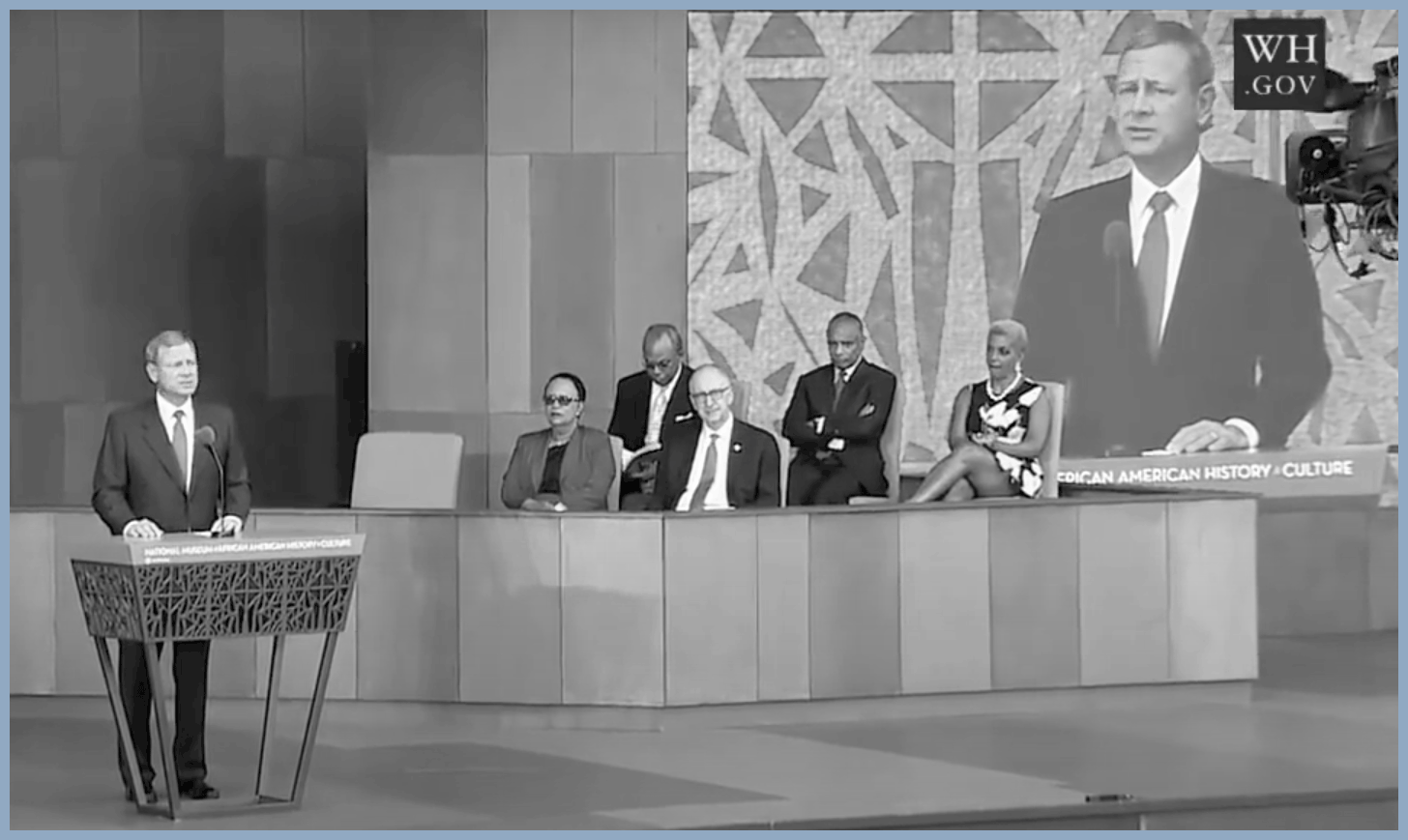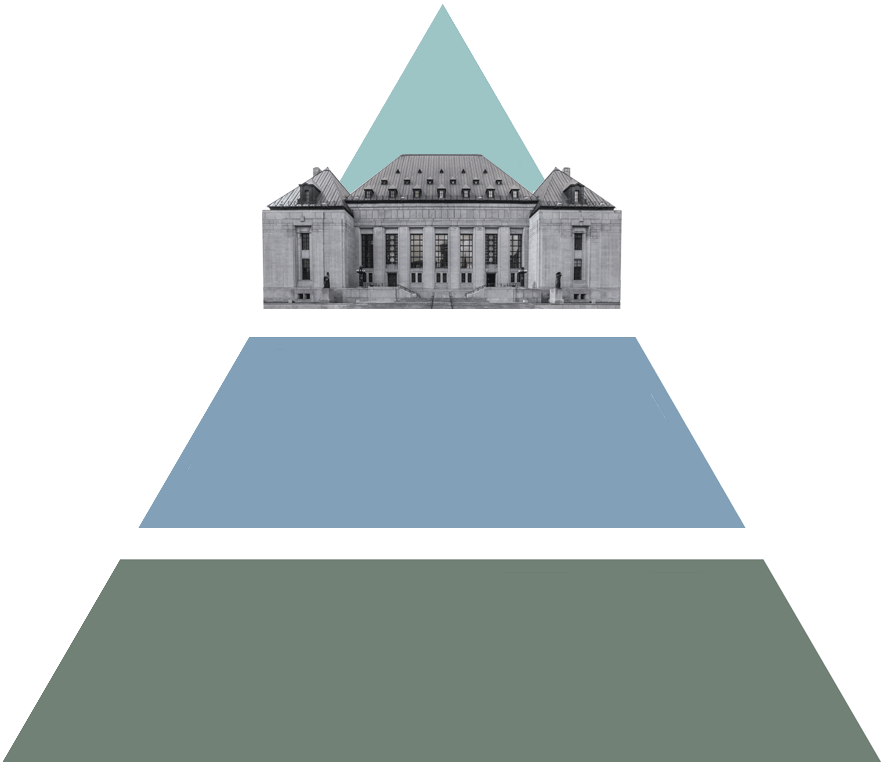
Nations have adopted different titles for their highest courts of appeal ; these courts also have varying numbers of judges and diverse methods for selecting them. Although all apex courts serve as final courts of appeal, they also may be assigned additional responsibilities. In some countries, there are specialized supreme courts: criminal commercial, and administrative.
Courts of Cassation
In most civil law systems, the ‘highest’ court on the interpretation of law is the court of cassation. While the supreme court may review questions of law and fact, the court of cassation only rules upon the legality of a judgment. However, in some countries, like Egypt, the court of cassation can reverse a judgment based on insufficient evidence as a matter of law. Cassation courts were developed to preserve uniformity in the application of law, and some may issue guidance to the lower courts on new or complex legal issues, as is the case in France.
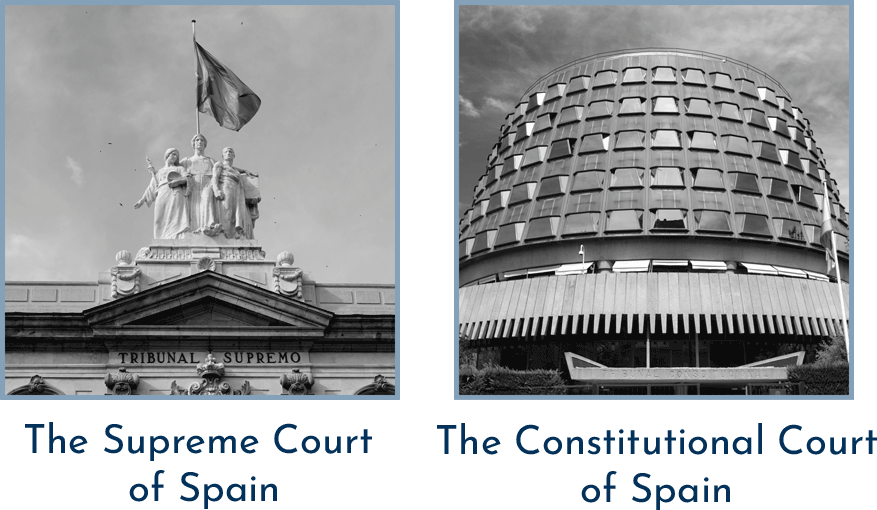
Constitutional Courts & Councils of State
Many countries have constitutional courts; they serve as the final arbiter of cases raising constitutional questions. In France, Greece, and Turkey, the Council of State is the final arbiter for administrative law cases. These two institutions may not be formally part of the judiciary. Regardless, they are often accorded co-equal stature with the supreme court.

Nomenclature
Countries have various titles for their highest courts.
For example:
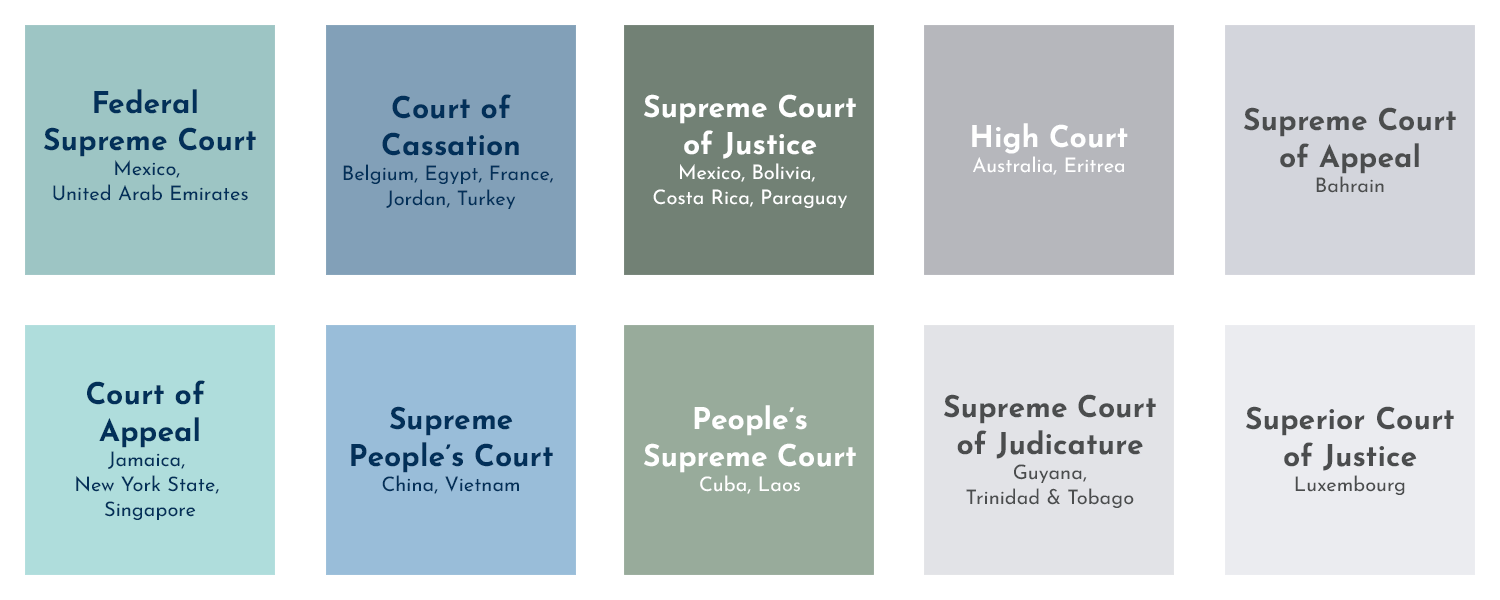
Justices
While many countries keep their supreme courts lean, either by tradition or due to the size of the country, in other countries these courts can have more than 100 justices.
Cases may be assigned to divisions, chambers, or panels of varying sizes ¬– usually divided into civil, criminal, and administrative matters. Austria’s 58-member supreme court has 17 panels: six hear criminal cases, ten hear civil cases, and one hears anti-trust matters. Thailand’s supreme court has eight specialized divisions including labor, tax, intellectual property, and family. The supreme court of Israel sits in panels of three justices. In Japan, a five-justice panel is referred to as a ‘petty bench.’ Even in countries where justices sit in panels, certain cases are heard by all of the justices en banc. The nine justices on the Supreme Court of the United States sit en banc for every case.
How Many Justices on a Supreme Court?
The Appointment Process
In most countries, supreme court justices are formally appointed by the president, prime minister, or monarch. Other methods include selection by a judicial council, nominating commission, or committee. Commissions and councils typically include representatives from the judiciary or bar, along with the executive and legislative branches. Alternatively, the legislative branch may be involved in the initial selection or final confirmation process.
There are many variations of these models. For example, Turkey’s High Council of Judges and Prosecutors appoints justices by secret ballot. Associate justices on Jamaica’s supreme court are appointed by the governor-general, who is advised by the Judicial Service Commission. A judicial appointment to Ghana’s supreme court requires selection by a nominations committee, a presidential nomination, and approval from parliament. Supreme court justices in the United Arab Emirates are appointed by the president after approval by the Federal Supreme Council – the highest legislative and executive body.
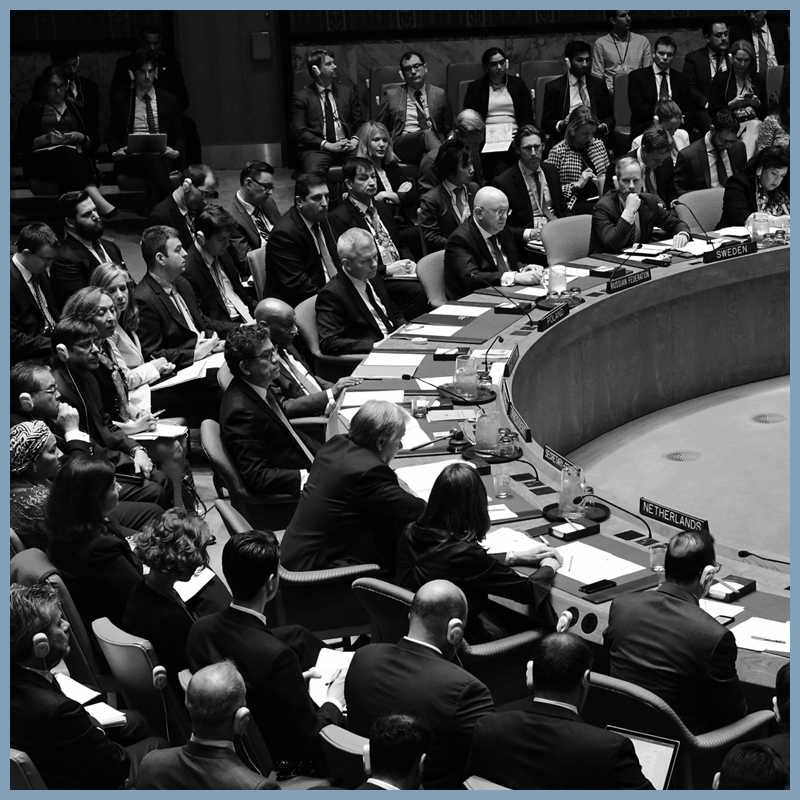
Independent Commissions
In a 1999 reform designed to separate the judicial appointment process from politics, Denmark changed the appointment process for all judges, including members of its supreme court. Judges are nominated by the independent Judicial Appointments Council and formally appointed by the minister of justice. The Council is composed of a supreme court justice, a high court judge, a district court judge, a lawyer and two representatives of the public. The United Kingdom instituted a similar reform in 2005. Supreme court justices are selected by an independent commission and formally appointed with permission of the prime minister and the King.
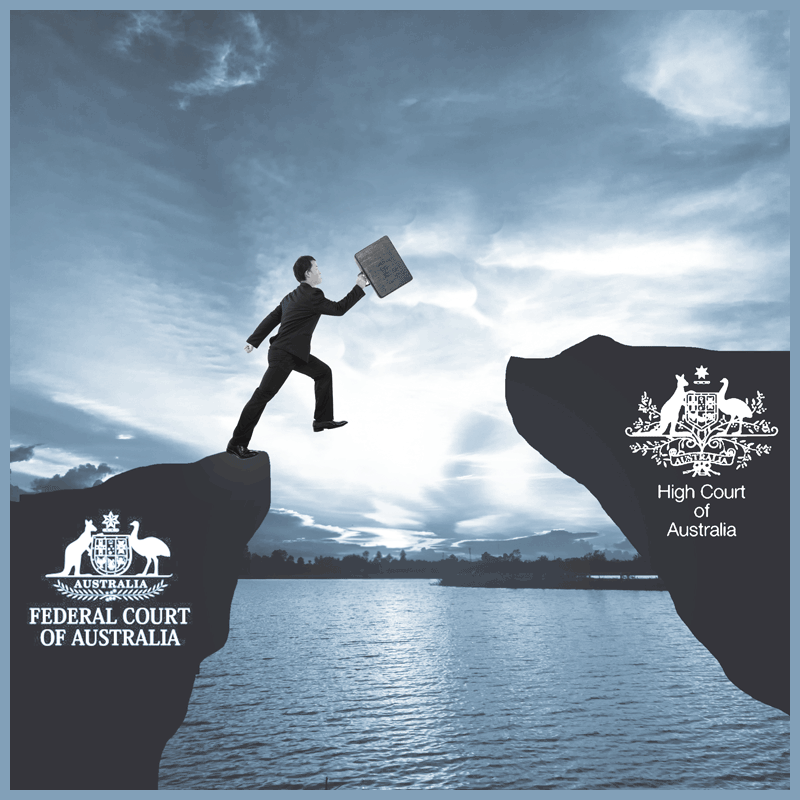
Dual Appointments
In some countries, judges from the high and appellate courts serve simultaneously as members of the supreme court. Examples of this model include Papua New Guinea and Singapore. Australia’s High Court has a chief justice, four resident judges, and sixteen other judges whose primary service is on the Federal Court of Australia but who also serve on the supreme court. In addition, the executive may appoint “acting” judges from the lower courts to serve on the supreme court for up to one year.
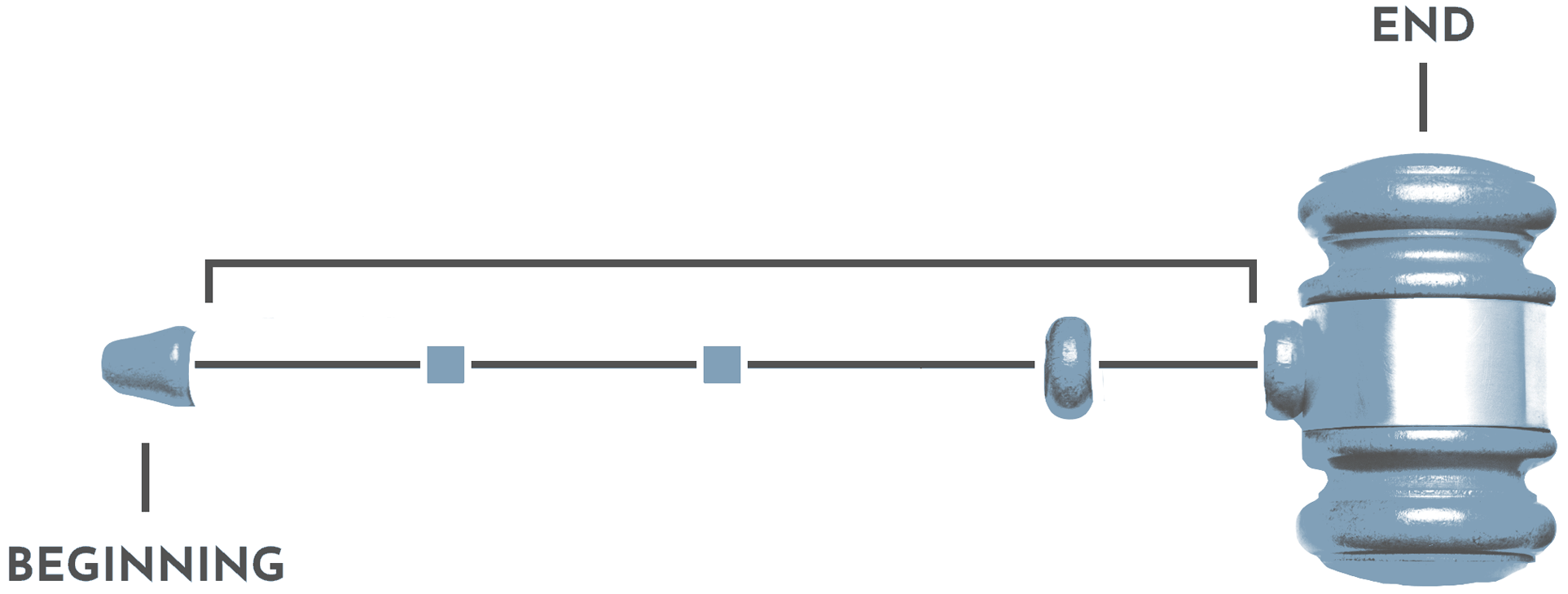
Tenure
Supreme court justices may be subject to a mandatory retirement age, appointed for a term of years, or given ‘life tenure’ with or without a mandatory retirement age.
In many countries, justices serve until a mandatory retirement age. For example, in Australia, Brazil, Denmark, Israel, Japan, Kenya, Korea, New Zealand, and the Philippines, and the United Kingdom justices must retire at age 70. In Canada, the mandatory retirement age is 75. Kazakhstan and Singapore have a mandatory retirement age of 65. Justices in India must retire at 62.
Most countries with term limits appoint justices for 9 – 15-year terms. However, in some countries the terms are quite short. For example, Guatemala’s supreme court justices serve a single four-year term.
Belgium, Canada, and Lebanon have ‘life tenure’ for justices coupled with a mandatory retirement age (70, 75, and 68 years of age, respectively). Justices of the Supreme Court of the United States have life tenure with no mandatory retirement age; U.S. justices often remain on the court into their 80’s and two served until the age of 90.
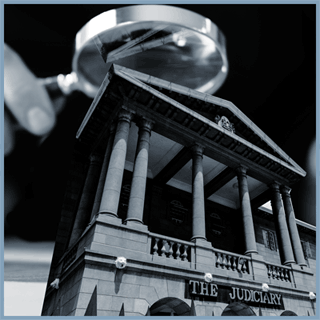
Responsibilities
Supreme courts hear appeals. Some also have original (first instance) jurisdiction over a limited category of disputes. Many supreme courts also have non-adjudicatory duties. Austria’s supreme court is responsible for commenting on draft legislation, hearing disciplinary matters concerning judges and lawyers, and reviewing nominations for court leadership positions. Indonesia’s supreme court is tasked with monitoring the lower courts as well as the conduct of judges, lawyers, and notaries; its duties extend to judicial administration and providing legal guidance to the president and other high state institutions. The Supreme Court of Slovenia has the right to ‘inspect’ lower court cases, including cases that have been closed. Litigants can file a petition with the court’s president requesting review of a case that has been subject to unreasonable delay.
In addition to hearing appeals, China’s near-400-member Supreme People’s Court presides over trials on matters of national importance, supervises the work of the lower courts, and issues binding interpretations of law and regulations on judicial policy. The court has several offices – including research, personnel, administration, foreign affairs and education – each managed by a justice.

Mandatory and Discretionary Review
Many supreme courts have the authority to select the cases they hear. The United States Supreme Court typically hears 80 cases a year out of 7,000 – 8,000 requests for review, and a minimum of four justices must consent to hearing a case. A three-justice panel of the Supreme Court of the United Kingdom reviews petitions for appeal; usually about 230 a year. In recent years, the court typically hears 80-90 of those petitions. In Denmark, a special board (composed of judges and lawyers) reviews petitions for supreme court review and selects the cases the court will hear. Israel’s supreme court has both discretionary and mandatory review. Thailand adopted discretionary supreme court review in 2015.
National supreme courts that do not have the discretion to select which cases to review often have very high caseloads. Morocco’s supreme court has over 40,000 pending cases; the court now has discretionary review but has over 60,000 pending cases. Nigeria’s apex court has over 10,000 pending cases. India’s supreme court also has a high caseload. Although there is a mechanism that empowers high courts to certify when a case is appropriate for appeal, such cases are a small part of the supreme court’s docket. Many criminal cases have an automatic appeal to the supreme court and most of the court’s cases are filed pursuant to ‘special leave to appeal’ petitions. The court may also have original jurisdiction over cases that claim a violation of fundamental rights.
In Brazil, a 2004 constitutional amendment gave the Federal Supreme Court a form of discretionary review. Petitioners must demonstrate that the issue being appealed will have significant economic, social, political, or legal implications beyond the dispute in question. In 2006, the number of cases before the court was just over 150,000; by 2016, this backlog was reduced to just over 60,000.
